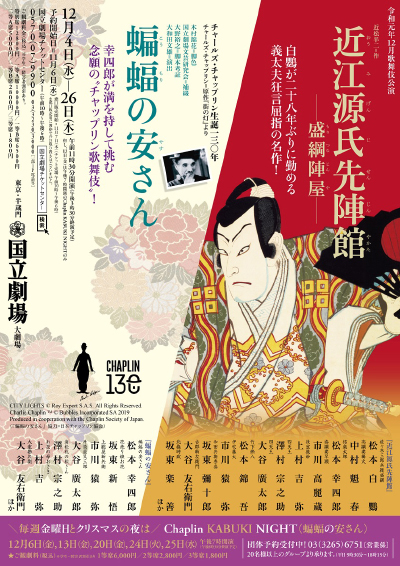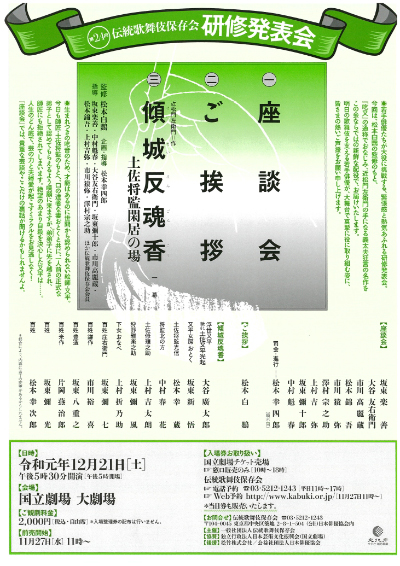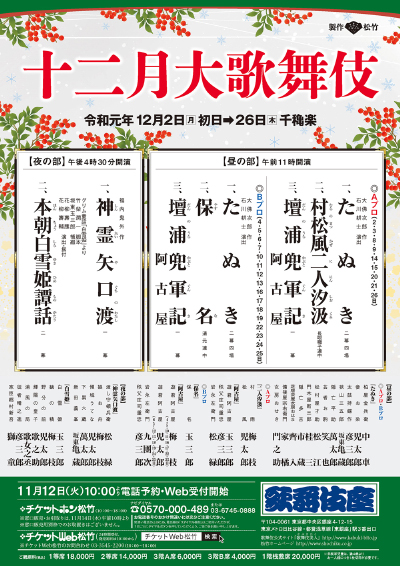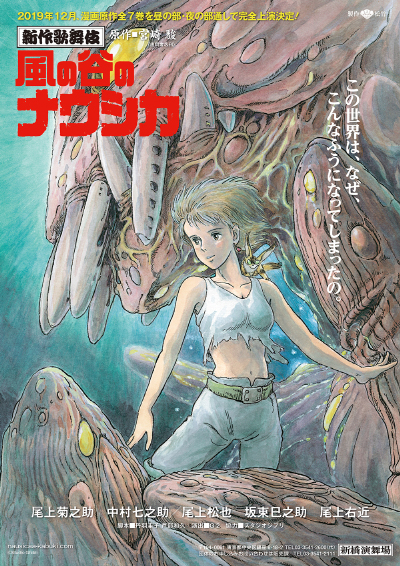| DECEMBER 2019 |
|
2 shows in Ky˘to (Minamiza) and 5 in T˘ky˘ (Kabukiza, National Theatre, Shinbashi Enbuj˘)!
|
|
|||
| Dates | 30 November ~ 26 December 2019 Kichirei Kaomise K˘gy˘ Annual Festive Face-Showing Performances |
||
| MatinÚe |
Shinshű Kawanakajima Kassen (Terutora Haizen) |
||
| Evening | |||
| Casting |
Living National Treasure Sakata T˘jűr˘, Living National Treasure Kataoka Nizaemon, Nakamura Tokiz˘, Nakamura Shikan, Nakamura Baigyoku, Nakamura Jakuemon, Nakamura Ganjir˘, Nakamura Senjaku, Kataoka Ainosuke, Kataoka Takatar˘, Kataoka Hidetar˘, Nakamura Kikaku, Nakamura Kazutar˘, Nakamura Hayato, Band˘ Shűch˘, Nakamura Kangyoku, Nakamura Hashinosuke, Kataoka Sennosuke |
||
| Comments |
The traditional kaomise in Ky˘to. Nakamura Kangyoku celebrates his shűmei in Ky˘to at the Minamiza.
|
||
 |
| National Theatre (T˘ky˘) |
| Dates | 4 ~ 26 December 2019 |
| Program A | |
| Program B | |
| Casting |
Matsumoto Haku˘, Matsumoto K˘shir˘, Nakamura Kaishun, Band˘ Yajűr˘, Band˘ Rakuzen, ďtani Tomoemon, Kamimura Kichiya, Ichikawa Komaz˘, Matsumoto Kingo, Ichikawa En'ya, Sawamura S˘nosuke, ďtani Hirotar˘ |
| Comments |
"K˘mori no Yasu-san", which was written by Kimura Kinka and premiered in August 1931 at the Kabukiza with Morita Kan'ya XIII in the role of K˘mori no Yasu, is a Kabuki adaptation of Charles Chaplin's 1931 movie "City Lights". It is revived at the National Theatre to commemorating the 130th Anniversary of Chaplin's Birth. Program A is staged everyday (except the 13th) at 11:00. Program B is staged at 19:00 the 6th, the 13th, the 20th, the 24th and the 25th. This program is entitled "Chaplin Kabuki Night".
|
 |
| Dates | 21 December 2019 (Dent˘ Kabuki Hozonkai Kenshű Happy˘kai) Training Recital of the Organization for the Preservation of Kabuki |
| Program |
Zadankai Goaisatsu Keisei Hangonk˘ (Domo Mata) |
| Casting | |
| Comments |
24th Training Recital at the National Theatre produced by the Organization for the Preservation of Kabuki. "Zadankai" (literally "Roundtable Discussion") is a stage talk with Matsumoto K˘shir˘, Nakamura Kaishun, Band˘ Rakuzen, ďtani Tomoemon, Koma1&, Matsumoto Kingo, Ichikawa En'ya, Sawamura S˘nosuke, Kamimura Kichiya, Band˘ Yajűr˘. "Goaisatsu" (literally "Greetings") is a stage speech delivered by Matsumoto Haku˘.
|
 |
| Kabukiza (T˘ky˘) |  |
| Dates | 2 ~ 26 December 2019 Jűnigatsu ďkabuki December Grand Kabuki |
| MatinÚe A |
Tanuki Mura no Matsukaze Ninin Shiokumi Dan no Ura Kabuto Gunki (Akoya) |
| MatinÚe B |
Tanuki Dan no Ura Kabuto Gunki (Akoya) |
| Evening |
Shinrei Yaguchi no Watashi (Tonbŕ Sumika) Honch˘ Shirayuki-hime Monogatari |
| Casting |
Living National Treasure Band˘ Tamasabur˘, Onoe Sh˘roku, Ichikawa Chűsha, Band˘ Hikosabur˘, Nakamura Shid˘, Kataoka Ichiz˘, Ichikawa Monnosuke, Nakamura Baishi, Nakamura Kotar˘, Ichimura Kakitsu, Ichikawa Sai'nyű, Nakamura Matsue, Ichikawa Emiya, Band˘ Kamez˘, ďtani Keiz˘, Nakamura Mantar˘, Ichikawa Kudanji, Nakamura Kamenoj˘ |
| Comments |
The usual December Grand Kabuki at the Kabukiza with two different matinÚe programs and one evening program:
|
 |
| Shinbashi Enbuj˘ (T˘ky˘) |  |
| Dates | 6 ~ 25 December 2019 |
| MatinÚe |
Kaze no Tani no Naushika (First Part) |
| Evening |
Kaze no Tani no Naushika (Second Part) |
| Casting |
Onoe Kikunosuke, Nakamura Shichinosuke, Nakamura Kinnosuke, Nakamura Karoku, Nakamura Matagor˘, Onoe Matsuya, Band˘ Minosuke, Kataoka Kamez˘, Kawarasaki Gonjűr˘, Ichimura Manjir˘, Nakamura Yonekichi, Onoe Ukon, Nakamura Kash˘, Nakamura Tanenosuke, Arashi Kitsusabur˘, Ichimura Kitsutar˘, Nakamura Kichinoj˘ |
| Comments |
Miyazaki Hayaoĺs masterpiece "Nausicań of the Valley of the Wind" [manga | movie] is adapted into Kabuki for the very first time! It is staged with Onoe Kikunosuke and Nakamura Shichinosuke in the roles of Nausicań and Kushana [more details].
|
 |
|
|
| Contact | Main | Top | Updates | Actors | Plays | Playwrights | Programs | Links | FAQ | Glossary | Chronology | Illustrations | Prints | Characters | Derivatives | Theaters | Coming soon | News |